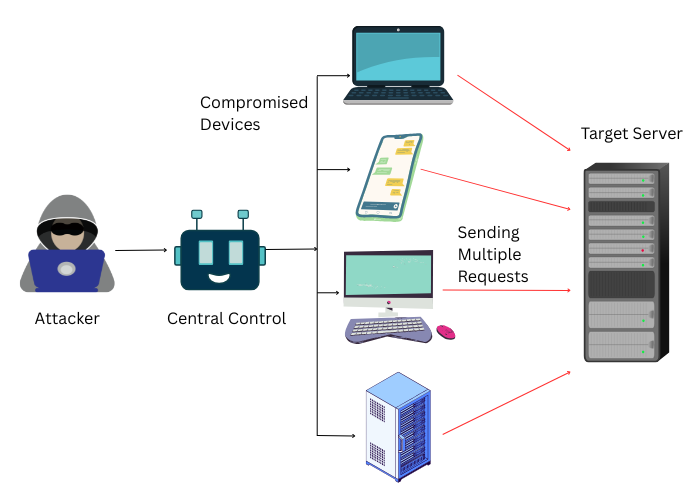
DoS and DDoS attacks are cyber attacks designed to disrupt the services of an application by flooding it with fake requests. While they may seem similar, the scale, method, and impact of DoS and DDoS attacks differ significantly.
In this article, we will discuss both DoS and DDoS attacks in Cyber security, to understand their working, impact, and characteristics. We will also provide a side-by-side comparison of DoS vs. DDoS to show the differences between them.
Furthermore, if you are interested in learning the practical methods of preventing these attacks, you can check out our Cyber security courses.
What are DoS and DDoS Attacks?
Denial of Service (DoS) and Distributed Denial of Service (DDoS) attacks are cyber attacks aimed at making a system, network, or website unavailable to users. They overwhelm the target with excessive traffic or requests, causing it to slow down or crash.
These attacks are commonly used to disrupt business operations, damage reputations, or distract security teams while other malicious activities occur.
Let's look at each of these attacks.
What is a DoS attack?
DoS stands for Denial-of-Service. Attackers make deliberate attempts to make online services slow, unreliable, or entirely inaccessible by flooding them with malicious traffic.
A DoS attack is launched from a single source or device, which sends an overwhelming amount of traffic or requests to a target system. The goal is to consume system resources, such as CPU, memory, or bandwidth, until the target becomes unresponsive or crashes.

Characteristics of DoS Attacks
Some unique characteristics of Denial of Service attacks are:
● Launched from one machine or IP address.
● Aims to exhaust system resources like CPU, RAM, bandwidth, or storage.
● Often causes service slowdown or complete unavailability.
● Focuses on disruption, not stealing or altering data.
Learn more about Denial of Service (DoS) Attack in Cyber Security.

What is a DDoS Attack?
DDoS stands for Distributed Denial of Service. Hackers make an unauthorized attempt to disrupt a targeted server, service, or network's normal operation by flooding it with a large volume of traffic from multiple sources. These sources are frequently compromised on PCs, Internet of Things gadgets, or bots that are part of a botnet.
They are very challenging to block because the attack occurs from multiple sites at the same time. They frequently target networks or websites to disrupt, extort, or harm their reputation.

Characteristics of DDoS Attacks
The following are the characteristics:
● DDoS attacks can target websites, online services, or entire networks, making them versatile in their impact.
● The scale of traffic generated during a DDoS attack can be massive, sometimes reaching hundreds of gigabits per second.
● Attackers may use different attack vectors simultaneously, such as volumetric attacks, protocol attacks, and application-layer attacks, to bypass defenses.
● DDoS attacks can be motivated by financial gain, political agendas, or as a smokescreen for other malicious activities.
DoS Attack vs DDoS Attack
Here’s a table showing the key differences between DoS and DDoS attacks:
| DoS and DDoS Attack Differences | ||
|---|---|---|
| Aspect | DoS Attack | DDoS Attack |
| Source of Attack | Single source | Multiple distributed sources |
| Detection Difficulty | Easier to detect | Harder to detect |
| Traffic Volume | Usually low to moderate | Very high, can be massive |
| Attack Method | One machine floods the target | Network of compromised devices (botnet) |
| Complexity | Lower complexity | Higher complexity requiring coordination |
| Impact Scope | Typically, smaller networks or services | Large-scale systems or entire infrastructures |
| Resource Requirement | Fewer resources needed | Requires control over many devices |
| Intent | Can be accidental or due to misconfiguration | Intentional and coordinated |
| Mitigation Approach | Blocking a single IP or simple filtering | Advanced traffic analysis and mitigation are needed |
| Duration | Usually shorter | Often longer, lasting hours or days |
Types of DoS and DDoS Attacks
DoS and DDoS attacks can vary significantly in their forms and targets. While some attacks may be minor, causing temporary disruptions, others can be severe enough to completely halt a service. Below is a list of common types of DoS and DDoS attacks:
1. Volumetric Attacks
These attacks aim to consume all available bandwidth between the target and the Internet.
Example: UDP Flood, in which attackers send massive amounts of User Datagram Protocol (UDP) packets to random ports on the victim's system, overwhelming the network.
2. Protocol Attacks (State-Exhaustion Attacks)
These attacks exploit weaknesses in protocols like TCP, DNS, and others by consuming resources of servers, firewalls, and load balancers.
Example: SYN Flood, in which the attacker sends numerous TCP SYN packets to initiate a connection but never completes the handshake, exhausting server resources.
3. Application Layer Attacks (Layer 7 Attacks)
These attacks target specific application functions by sending seemingly legitimate and well-formed requests that overwhelm the application.
Example: HTTP Flood, in which the Attackers send a flood of HTTP GET or POST requests to a website, overwhelming the server.
4. DNS Amplification
This is a reflection-based volumetric attack where small queries generate large responses.
Example: A 60-byte DNS query can generate a 4,000-byte response, allowing attackers to flood the target with high-bandwidth traffic.
5. NTP Amplification
This attack abuses the Network Time Protocol (NTP), particularly the monlist command, which returns a list of the last 600 IP addresses that requested time from the server.
Example: Attackers send a small forged NTP request to multiple NTP servers, and each sends a large response to the victim, amplifying the attack’s scale.
6. Slowloris Attack
Slowloris keeps many connections to the target web server open and holds them open as long as possible by sending partial HTTP requests.
Example: The attacker sends incomplete HTTP headers at regular intervals, preventing the server from closing the connections and eventually exhausting its connection pool.
What is More Dangerous Between DDoS and DoS Attack?
Distributed Denial of Service attacks are generally more dangerous and impactful than Denial of Service attacks due to their scale, complexity, and difficulty in mitigating.
Here's Why:
● DDoS attacks come from a botnet, making it much harder to trace and block the malicious traffic.
● DDoS attacks can generate enormous traffic volumes, often enough to bring down even large, well-protected networks or websites.
● DDoS attacks often use multiple attack vectors at once (e.g., volumetric, protocol, and application-layer attacks), making defense more complex.
● DDoS attacks can cause prolonged service outages, lead to financial losses, damage reputation, and even data breaches in some cases.
How to Prevent DoS and DDoS Attacks?
Combating DoS and DDoS attacks requires a multi-layered security strategy:
| Strategy | Description |
|---|---|
| Firewalls and IDS/IPS | Filters and blocks malicious traffic using predefined rules; detects suspicious patterns early. |
| Rate Limiting | Restricts the number of requests a user or IP can make within a certain time frame. |
Content Delivery Network (CDN) | Distributes content across multiple servers to absorb and mitigate traffic spikes. |
| Load Balancing | Distributes incoming traffic evenly across multiple servers to avoid overloading a single system. |
| Regular Security Updates | Patches known vulnerabilities in operating systems, software, and network devices. |
| Traffic Filtering | Uses filtering rules or ACLs to block suspicious or malformed packets. |
| DDoS Protection Services | Specialized third-party services that detect, absorb, and mitigate DDoS traffic (e.g., Cloudflare, Akamai). |
| Network Redundancy | Uses backup systems and alternate network paths to maintain availability during attacks. |
| Anomaly Detection | Monitors traffic behavior and alerts on unusual patterns that may indicate an ongoing attack. |
| Incident Response Planning | Prepares teams with protocols and tools to respond quickly and effectively to attacks. |
Conclusion
While both DoS and DDoS attacks aim to disrupt services, they differ greatly in their execution and impact. DoS attacks are simpler and easier to control, while DDoS attacks are more complex and damaging.
Understanding these differences is crucial for network administrators and cybersecurity professionals to build resilient defenses and respond effectively when under attack.
Proactive planning, real-time monitoring, and adopting strong mitigation tools are the best defenses against these disruptive threats.

Amar Singh is a senior security architect and a certified trainer. He is currently working with a reputed organization based out of India. His accomplishments include CCNA, CCNP Security, CEH, Vmware, Checkpoint and Palo Alto Certifications. He is holding more than 12 years of experience in Network security domain. In his career he has been ...
More... | Author`s Bog | Book a MeetingFAQ
Comments (0)
Popular posts


Different Types of Network Topologies ...
10 Nov 2025
CCNA Exam Fees and Expenses Breakdown
25 Aug 2025
New Cisco CCNA Syllabus for 2025
8 Nov 2025
What is a Cloud Service Provider and Top ...
7 Nov 2025Recent posts

What are the Best Cloud Computing ...
28 Nov 2025
Top 10 Advantages and Disadvantages of ...
28 Nov 2025
Cloud Computing Virtualization - ...
28 Nov 2025
What are the Uses of Cloud Computing?
28 Nov 2025
CCNP Certification Cost and Exam Fees
28 Nov 2025Upcoming batches
Contact learning advisor

.png)







